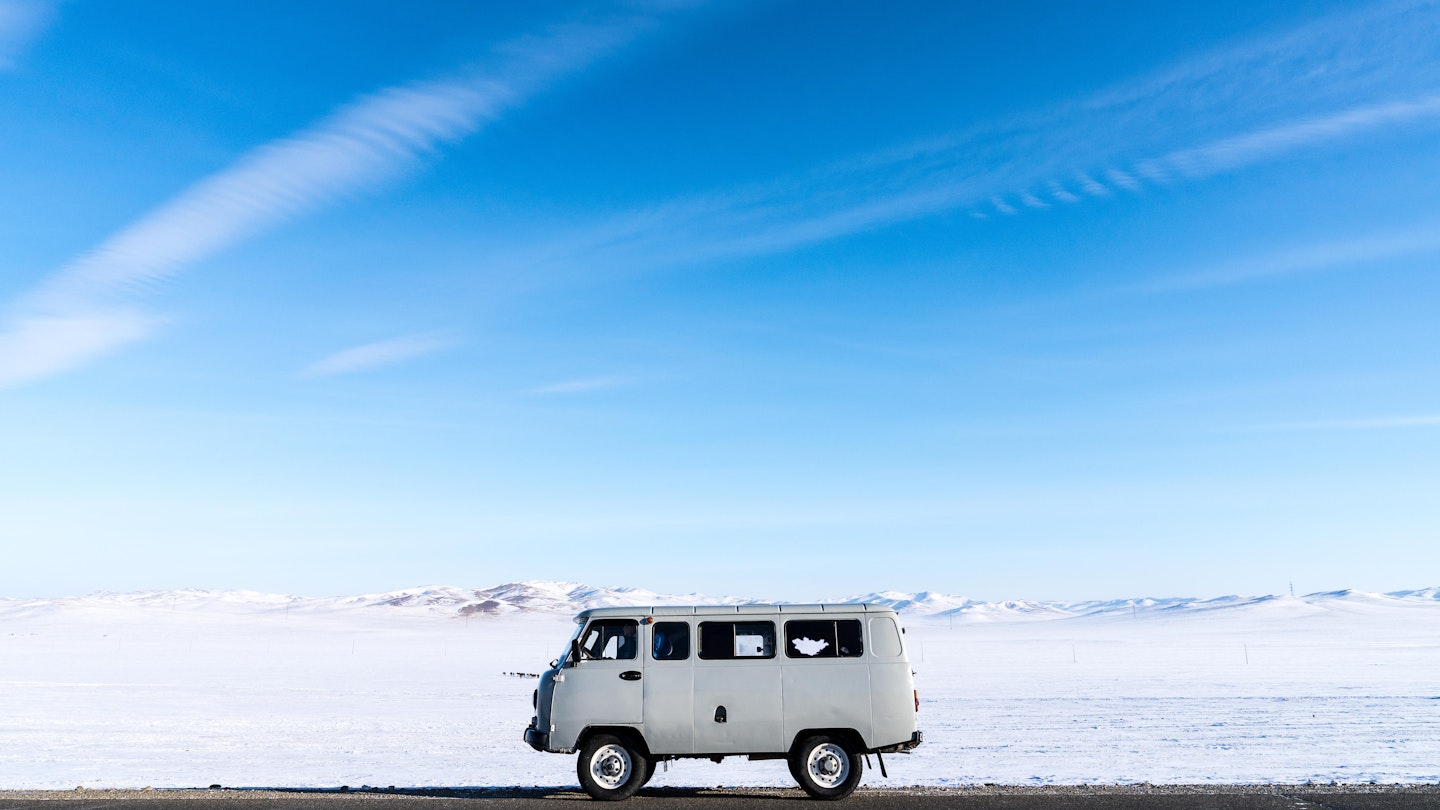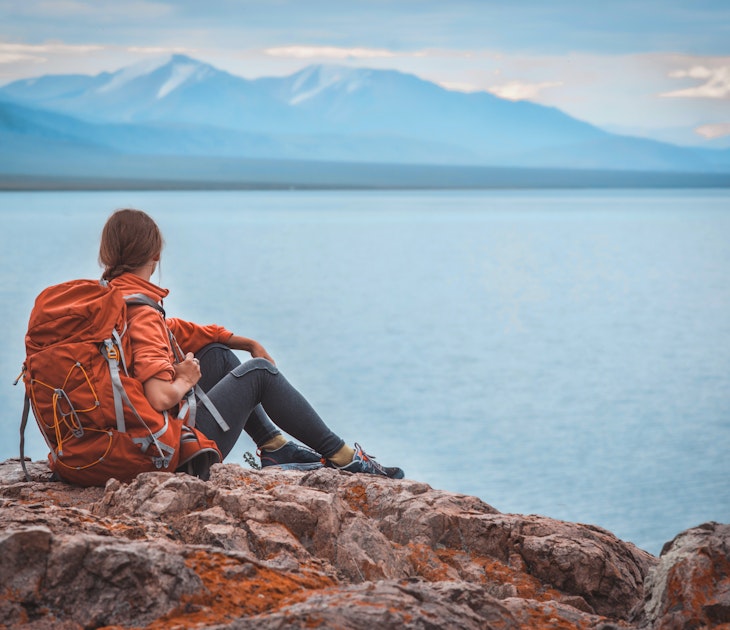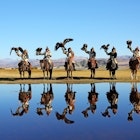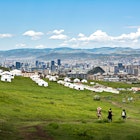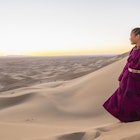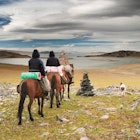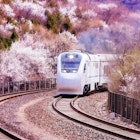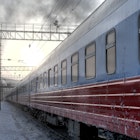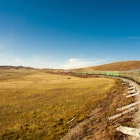Imagine bouncing over rolling grasslands in a 4WD, with nothing but rolling green steppe extending in every direction. Mongolia is proof that roads (of the asphalt variety) are by no means essential for a road trip.
Such is the boundless landscape of Mongolia that awesome road trip adventures can be found just about anywhere you point your steering wheel.
In fact, most tours in Mongolia are cross-country driving itineraries, with a 4WD vehicle, driver and English-speaking guide provided as part of the package. For more control over the route, you can hire a private car and driver, or even get your own wheels and go it alone.
Whichever option you choose, you’re guaranteed dreamlike drives through some of the most mesmerizing and least populated landscapes on the planet. Here are three of our favorite Mongolia road trips to set you off on your journey.

1. Classic Mongolia Loop
Best road trip for sightseeing
Ulaanbaatar–Karakorum–South Gobi; from 1700km (1050 miles); allow from 5 days
Starting in Ulaanbaatar, this road trip packs in a lot of stops, starting with the remarkable Erdene Zuu Monastery in Kharkhorin, 360km west of the capital, and accessible via paved roads. Founded in 1586, Mongolia’s most important Buddhist site was built from the scattered ruins of Karakorum, the ancient capital founded by the son of Chinggis (Ghengis) Khan three centuries earlier.
Stop overnight in a ger (yurt) camp by the Orkhon River before venturing into the desert wilds of the mighty Gobi. The forlorn ruined monastery at Ongiin Khiid breaks up the epic, bumpy drive south to Ömnögovi – translating to ‘southern Gobi’ – the county’s driest, hottest and least populated province.
Much of the next phase of the trip is on unpaved tracks through sparsely vegetated steppe and rocky desert. You’ll need three to four days to visit the main sights, with a good choice of tourist ger camps at each stop.
First up are the eerily beautiful "flaming cliffs" of Bayanzag, the first place on Earth where dinosaur eggs were discovered, along with the remains of over 100 dinosaurs. Driving 150km southwest gets you to Khongoryn Els, where vast sand dunes soar up to 80m high.
Around 220km eastwards, in the wildlife-rich Yol Valley, you can hike, bike or ride a horse through a dramatic gorge in which seams of blue ice survive well into June. Keep going east to the provincial capital Dalanzadgad, where it’s back onto paved roads for the 550km straight shot north to Ulaanbaatar.
Planning tip: Aim to be in Khongoryn Els in the late afternoon with your camera ready – the dunescape is at its most photogenic in the light of the setting sun.

2. Discovering Khövsgöl Nuur
Best road trip for adventurous self-drivers
Ulaanbaatar–Khövsgöl Nuur; 900km (560 miles); allow three days
Set amidst Siberian taiga (snow forests) and the craggy peaks of Mongolia’s far north is Khövsgöl Nuur, the shimmering blue "Mother Sea" of Mongolia. Mongolia’s second largest and deepest lake is connected to the capital, Ulaanbaatar, by paved roads, and you can drive straight here in 10–12 hours, but it’s much better to plot a multi-day adventure so you can stop at sights in the intervening aimags (provinces).
The route to Khövsgöl Nuur gets busy in summer but that’s not a bad thing when you’re self-driving. More locals on (and off) the road means more chances for help if you run into difficulties – always a possibility in this rugged terrain.
Some 300km out from the capital, you’ll leave the asphalt behind in Selenge aimag to reach Amarbayasgalant Khiid, a lost-in-time Buddhist monastery complex backed by mountains. There are ger camps nearby where you can stop overnight, or you can bed down in Erdenet, Mongolia’s third largest city, 110km west of the monastery.
The next day’s drive crosses Bulgan province with a stop at Uran-Togoo Tulga Uul Nature Reserve, a protected forest area home to an extinct, bowl-shaped volcano, with hiking trails up to the 500m-wide caldera. After a night’s camping along the banks of the Selenge – the major river that feeds Lake Baikal in Russia – keep heading west to the transport hub of Mörön, a rare outpost of civilization in these parts.
Just west of town is Uushigiin Uver, a Bronze Age archaeological site of "deer stone" statues carved between 2500 and 4000 years ago. From Mörön, it’s a 1½ hour drive north to Hatgal, a cheerful soum (township) of wooden houses and tourist lodges that marks the gateway to Khövsgöl Nuur.
Detour: A paved road continues along the lake’s western shore, which suffers a little from over-tourism and litter as a result. There is a track along the unspoiled eastern shore but it's extremely rough-going; it’s better to park up in Hatgal and catch a boat to the Ar Davhar Eco Camp, a secluded lakeside ger camp with solid eco credentials.

3. An Altai Mountains Odyssey
Best road trip for Kazakh culture
Ölgii–Altai Tavan Bogd National Park; 250km (155 miles); allow 2–3 days
Most people fly to the city of Ölgii to start this road trip through Mongolia’s westernmost aimag, as this dusty frontier town is a 36-hour nonstop drive from Ulaanbaatar. Bayan-Ölgii is Mongolia’s most mountainous region, with many peaks over 4000m high, permanently covered by glaciers and snow. About 90% of the region’s population is Kazakh, and locals erect larger and more richly decorated gers than the standard Mongolian version.
Mongolia’s Kazakhs are also famous for their winter pastime of hunting using trained eagles. This rewarding road trip passes through the township of Sagsai where you can visit local eagle hunters (some years, a small eagle festival is held here in September). After Sagsai, it’s a wild run through dramatic river valleys, home to mountain ibex and dotted with rocks carved with ancient petroglyphs. Eventually, you’ll arrive at the north ranger station of Altai Tavan Bogd National Park.
The final run-up to the 12km-long Potanii Glacier is hard going, but the views are worth it. There’s fine camping to be had at Khuiten Uul Base Camp (3092m), under the gaze of Mongolia’s highest mountain.
Planning tip: You’ll need ice axes, crampons and an experienced local guide to attempt the ascent of Khuiten Uul (Cold Peak, 4374m), but nearby Malchin Peak (4050m) has a non-technical path all the way to the summit.

Tips for self-driving on a road trip in Mongolia
If you choose to self-drive in Mongolia, it’s wise not to stray too far from the network of paved roads that fans outwards from the capital Ulaanbaatar. Without local intel, it’s all too easy to come a cropper crossing swollen rivers, or get bogged down in mud and sand.
In July and August, the steppe can become extremely waterlogged. Driving is easier in the shoulder seasons of May–June and September, and in winter when the ground freezes. When driving in extremely remote areas such as Khermen Tsav or the Great Gobi protected area, there are no facilities and nobody around to help if you run into difficulties. You should be expedition-equipped and have a minimum of two vehicles in your party.
There’s some general advice to follow anywhere in Mongolia. Fuel up often, even if your tank is half-full, as petrol shortages are not uncommon. Carry enough cash to last the whole trip and bring blankets, food and the means to purify water in case you get stuck in a remote location.
As well as carrying a mobile phone, it pays to get a GPS tracker device – it will enable your tour operator or the authorities in Ulaanbaatar to locate your whereabouts if necessary. Always carry a backup physical paper map and compass in case your tech lets you down.

